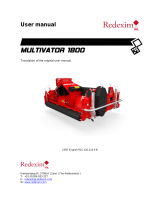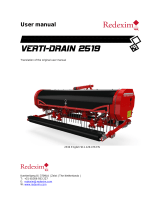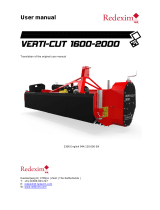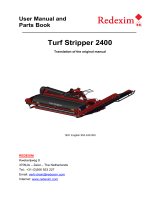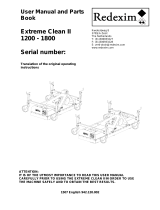Page is loading ...

EU – DECLARATION OF CONFORMITY
We,
Redexim Handel- en Exploitatie Maatschappij B.V.
Kwekerijweg 8
3709 JA Zeist, The Netherlands
declare that this “EU - DECLARATION OF CONFORMITY” is issued under our sole
responsibility and belongs to the following product:
BLECAVATOR WITH MACHINE NUMBER AS INDICATED ON THE MACHINE AND IN THIS
MANUAL,
to which this declaration refers, complies with stipulation of:
2006/42/EC Machinery Directive
and with the standards:
• ISO 12100-1:2010 Safety of machinery - General principles for design - Risk assessment and
risk reduction
• ISO 13857:2019 Safety of machinery - Safety distances to prevent hazard zones being
reached by upper and lower limbs
• ISO 4254-1:2015 Agricultural machinery - Safety - Part 1: General requirements
• ISO 4254-5:2018 Agricultural machinery - Safety - Part 5: Power-driven soil-working machine
Zeist, 03-01-2022
C.H.G. de Bree
Redexim Handel- en Exploitatie Maatschappij B.V.

UK – DECLARATION OF CONFORMITY
We,
Redexim Handel- en Exploitatie Maatschappij B.V.
Kwekerijweg 8
3709 JA Zeist, The Netherlands
declare that this “UK - DECLARATION OF CONFORMITY” is issued under our sole
responsibility and belongs to the following product:
BLECAVATOR WITH MACHINE NUMBER AS INDICATED ON THE MACHINE AND IN THIS
MANUAL,
to which this declaration refers, complies with stipulation of:
S.I. 2008 No. 1597 HEALTH AND SAFETY The Supply of Machinery (Safety) Regulations
2008
and with the standards:
• ISO 12100-1:2010 Safety of machinery - General principles for design - Risk assessment and
risk reduction
• ISO 13857:2019 Safety of machinery - Safety distances to prevent hazard zones being
reached by upper and lower limbs
• ISO 4254-1:2015 Agricultural machinery - Safety - Part 1: General requirements
• ISO 4254-5:2018 Agricultural machinery - Safety - Part 5: Power-driven soil-working machine
Zeist, 03-01-2022
C.H.G. de Bree
Redexim Handel- en Exploitatie Maatschappij B.V.

FOREWORD
Congratulations on your Blecavator 145 / 210 purchase. For safe and long-lasting operation of this
machine, it is necessary to read and to understand this user manual. It is impossible to work safely
with this machine without complete knowledge of the content of the user manual.
This machine does not operate independently! It is the user’s responsibility to use the correct tractor or
other towing vehicle. The user should check the combination of the towing vehicle and the machine
with regard to various aspects, such as noise level and safety risks. In addition, the user should
comply with the user instructions of the vehicle and spare parts that are used.
All information and technical specifications provided at the moment that this document is published are
the most recent ones. Design specifications may be changed without prior notice.
You can contact your sales point or dealer if you have questions and/or if there are ambiguities in this
manual or about the machine concerned.
This document is a translation of the original user manual. Upon request, the original user manual is
available in Dutch.
WARRANTY CONDITIONS
AT THE TIME OF DELIVERY THIS MACHINE IS GUARANTEED AGAINST MATERIAL DEFECTS.
THIS WARRANTY IS VALID FOR A PERIOD OF 12 MONTHS FROM THE PURCHASE DATE.
REDEXIM WARRANTIES ARE SUBJECT TO THE ‘GENERAL CONDITIONS FOR SUPPLY OF
PLANT AND MACHINERY FOR EXPORT, NUMBER 188’ THAT ARE PUBLISHED UNDER THE
AUSPICES OF THE UNITED NATIONS ECONOMIC COMMISSION FOR EUROPE.
REGISTRATION CARD
For your own information, fill in the table below:
Serial number of the machine
Dealer name
Date of purchase
Remarks

5
TABLE OF CONTENTS
EU – DECLARATION OF CONFORMITY ............................................................................... 2
UK – DECLARATION OF CONFORMITY ............................................................................... 3
FOREWORD ............................................................................................................................ 4
WARRANTY CONDITIONS ..................................................................................................... 4
REGISTRATION CARD ........................................................................................................... 4
1. SAFETY INSTRUCTIONS ........................................................................................... 6
1.1. Obligations of the user ..................................................................................................... 6
1.2. Maintenance, repairs and adjustments ............................................................................ 7
1.3. Using the machine ............................................................................................................ 7
2. TECHNICAL DATA ...................................................................................................... 8
3. GENERAL DESCRIPTION .......................................................................................... 8
4. SAFETY STICKERS .................................................................................................... 9
5. FIRST INSTALLATION .............................................................................................. 10
6. THE PTO AXLE ......................................................................................................... 12
6.1. Length of the PTO axle ................................................................................................... 12
6.2. Using the PTO axle ......................................................................................................... 13
7. ATTACHING AND DETACHING THE MACHINE ..................................................... 14
7.1. Attaching the machine ................................................................................................... 14
7.2. Detaching the machine ................................................................................................... 15
8. TRANSPORT ............................................................................................................. 16
9. PUTTING THE MACHINE INTO OPERATION .......................................................... 17
9.1. Safety ............................................................................................................................. 17
9.2. Working speed ............................................................................................................... 17
9.3. Start/Stop procedure ..................................................................................................... 17
10. TECHNICAL INFORMATION .................................................................................... 18
10.1. Adjusting the working depth .......................................................................................... 18
10.2. Putting the rear roller off centre ..................................................................................... 19
10.3. Adjusting the levelling bar .............................................................................................. 19
10.4. Pin rack .......................................................................................................................... 21
11. OPTIONS ................................................................................................................... 22
11.1. Angled knives ................................................................................................................. 22
12. MAINTENANCE ......................................................................................................... 23
12.1. Maintenance schedule ................................................................................................... 23
12.2. Cleaning ......................................................................................................................... 24
12.3. Lubrication points .......................................................................................................... 24
12.4. Changing the oil in the drive ........................................................................................... 25
12.5. Checking the grease level in the rotor’s bearing house. .................................................. 27
12.6. Replacing the knives. ...................................................................................................... 28
13. TROUBLE SHOOTING (PROBLEM ANALYSIS) ..................................................... 29

6
1. SAFETY INSTRUCTIONS
This machine is designed for safe use. This can only be achieved if you completely follow the safety
instructions described in this manual.
Read and understand the manual before you start using this machine.
If the machine is not used as described in this manual, this can result in injuries and/or damage to the
machine.
This user manual lists instructions that are numbered in sequence. You should follow this sequence. A
is an indication of a safety instruction. A means a tip and/or note.
1.1. Obligations of the user
The machine is solely intended for work on fields that should be cultivated. Any other use is improper.
The manufacturer will not accept any liability for damage resulting from improper use. All risks
occurring with this are entirely at the expense of the user.
All persons assigned to operate, maintain and repair the machine by the owner must completely read
and understand the operation manual and in particular the chapter of Safety Instructions.
Modifications to the machine that have a negative impact on the safety must be rectified immediately.
The user is obliged to check the machine for visible damage and defects before using the machine.
For safety reasons it is not permitted to make changes or adjustments to the machine (except those
approved by the manufacturer). If modifications to the machine have been made, then the current CE
marking is cancelled. The person that has made these modifications has to apply for a new CE
marking himself.
Following the use, maintenance and repair instructions prescribed by the manufacturer is also
considered proper use of this machine.
The user is responsible for the safe combination of the machine and the towing vehicle, which comply
with the requirements as described in the Technical Data (see Chapter 2). This entire combination
should be tested for noise, safety, risk and user friendliness. User instructions should also be drafted.
Dress appropriately during work activities with the machine. Wear certified safety shoes with steel
toecaps, long trousers and tie up long hair. Do not wear loose clothing.
The general applicable health & safety (Dutch: ARBO) regulations must also be followed in addition to
the instructions in this user manual.
Relevant traffic regulations also apply in case of using public roads.

7
1.2. Maintenance, repairs and adjustments
Keep a record of the repair activities.
When unskilled people use, maintain or repair the machine, this could result in injuries to the user and
to third parties. This should be avoided!
Use only original Redexim parts for maintenance or repairs because of the safety of the machine and
of the user.
Only authorised technical personnel may carry out repairs to the machine.
When carrying out maintenance, adjustments and repairs, it is necessary to block the machine in
order to prevent it from sinking away, driving off and/or sliding off.
Used oil/grease is harmful to the environment. Dispose of these substances according to the
regulations that apply in your location.
1.3. Using the machine
Attach the machine to the towing vehicle according to the regulations. Pay close attention to the risk of
injury!
Never use the machine in the absence of protective guards and safety stickers.
Check the machine for loose bolts, nuts and components before every operation.
Check whether you have a clear field of vision – both close by and far away – before you start moving.
All persons that are going to operate the machine must be familiar with all the functions and control
elements of the machine before starting any work activities.
Never crawl under the machine! If necessary, tip over the machine to work at the bottom side.
If present, check the hydraulic hoses regularly and replace these when the hydraulic hoses are
damaged or appear old.

8
2. TECHNICAL DATA
Type
145
210
Recommended vehicle
35 - 65 hp with a minimum lifting
capacity of 800 kg (1764 lbs) at
610 mm (24”) behind the lifting
eyes
60 - 90 hp with a minimum lifting
capacity of 1000 kg (2205 lbs) at
610 mm (24”) behind the lifting
eyes
Working width
1.45m (57.1”)
2.1m (82.7”)
Working depth
100 – 180 mm (4”-7”)
Working speed
Depending on the conditions and the required result
PTO speed
540 rpm
Number of disks
9
13
Number of cutter knives per
disc
6
6
Total number of cutter knives
54
78
Weight in kg
751 kg (1656lbs)
911 kg (2008lbs)
Dimensions (L x W x H)
1.61x1.87x1.07 m
(63.4”x73.6”x42.2”)
1.61x2.51x1.07 m
(63.4”x98.7”x42.2”)
Three-point system
Cat. 1-2
Oil gearbox
GL-5 80W90 (3.4 ltr. / 0.90 gal.)
GL-5 80W90 (3.55 ltr. / 0.94 gal.)
Oil drive
SAE 140EP (2.0 ltr. / 0.53 gal.)
Grease bearings
EP2
Standard components
- Rear roller
- Adjustable levelling bar
- Pin rack
- Set of cutter knives
- PTO with slip coupling
Optional
Angled knives
3. GENERAL DESCRIPTION
The Blecavator 145 / 210 is a cultivating machine for preparing the subsoil (e.g., seeding a lawn).
The Blecavator 145 / 210 is a 3-point machine. You will need a tractor in order to use the Blecavator
145 / 210.

9
4. SAFETY STICKERS
Safety stickers are attached to both sides of the machine. These safety stickers must always be
clearly visible and legible and must be replaced if they have become damaged (see Fig. 1).
Fig. 1
921.280.402
- In case of maintenance, adjustments and repair,
always switch OFF the engine of the towing
vehicle and the PTO. Prevent the combination
from driving and/or sliding away.
- Keep a distance of minimum 4 metres if the
machine is operating (except the operator sitting in
the towing vehicle).
- During operation, NO persons are allowed within
the danger zone of the machine, because there is
danger of physical injuries caused by moving
parts.
900.280.402
- Prior to using the machine, the operators of the
machine must read the user manual carefully.
900.260.422
- You can operate the machine safely, if the PTO
does not exceed 540 rpm.

10
5. FIRST INSTALLATION
The machine should be prepared for use as follows (see Fig. 2):
Make sure that the cable/crane/lift can hoist minimum twice the weight of the machine. (See
Chapter 2: Technical Data for the weight.)
1. Attach a cable to the two hoisting points (1) and one around the rear roller (2).
Keep a safe distance. The machine may start to turn/slide away during hoisting/lifting!
Never crawl under the machine!
2. Carefully lift the machine including the pallet to approx. 100 mm (4”) off the ground.
3. Loosen the pallet (4) by removing the pins (3).
4. Lift the machine and off the pallet.
5. Slowly lower the machine and tilt it until it stands safely on the ground (see Fig. 3).
6. When the machine is off the pallet, remove the top plug of the gearbox and replace it with the
de-aerator included in the delivery.
Use a piece of wood under the machine to protect it.
Fig. 2

11
Fig. 3

12
6. The PTO AXLE
The PTO is a very important component that takes care of the drive from the tractor to the machine.
The PTO axle ensures safe use of the machine on condition that it is properly installed and
maintained. The PTO has its own CE certification and manual. This manual is located near the PTO
axle.
See the details listed on the PTO page of the components booklet for specific adjustment values.
DO NOT exceed these values. This could result in an unsafe situation and could overload the
machine, resulting in damage to the machine.
Fig. 4
6.1. Length of the PTO axle
The length of the PTO axle is very important. If it is too long, it can damage the drive of the tractor
and/or the machine. If the overlapping length of the cylinders becomes less than 250 mm (9.8”) at any
time, it can damage the PTO axle. The required length changes when the machine is lifted or when a
different tractor is used! If a new machine is purchased or if another towing vehicle is used, the length
of the PTO axle should be checked and shortened, if necessary (see Fig. 4):
1. Measure the distance ‘A’ (from groove to groove) between the tractor’s PTO and the machine’s
connection point, when the machine is horizontal on the ground and the tractor is attached.

13
2. Measure the distance ‘B’ of the PTO axle in its shortest position from the locking pin to the
locking bolt.
3. Divide the PTO axle in two parts and remove the protection cap at both ends.
4. The ends of the cylinders and the protection caps should be shortened: (B-A) + 125 mm (4.9”).
5. Smooth off all components and then assemble all components. For this purpose, use lubrication
grease.
6. Mount the PTO axle including the slip coupling at the machine side.
7. Attach the other end of the PTO axle to the tractor.
8. Check the overlap of the cylinders.
Never use the machine if it has a damaged PTO protection cap.
First replace the protection cap.
If the PTO is shortened incorrectly or if another tractor is used, the gearbox may be
overloaded and cause damage.
6.2. Using the PTO axle
The following items must be checked for correct use of the PTO axle:
1. The angle of the rotation points should always be smaller or equal to 30 degrees during work
activities.
2. The PTO axle of the tractor must be parallel to the PTO axle of the machine.
3. The overlap of the cylinders must always be minimum 250 mm (9,8”).
4. Never use the machine if it has a damaged PTO protection cap.
5. See the PTO manual for information about lubrication.

14
7. ATTACHING AND DETACHING THE MACHINE
Attaching and detaching the machine has to be done carefully. Follow the instructions below:
Fig. 5
7.1. Attaching the machine
Prior to attaching the machine, check the following points:
- Check whether the machine is undamaged and whether it is safe to attach and use the
machine.
- Check the machine for loose components and tighten them.
- Check whether all safety stickers are on the machine and whether these are undamaged and
easily readable. Never use the machine if it has damaged or unreadable stickers.
The machine should be attached to the tractor in the following manner (see Fig. 5):
1. Remove the 3-point pins (1) from the machine.
2. Carefully drive the tractor backwards until the lifting arms (2) can be attached to the machine.
!! Make sure that the tractor and the machine cannot move while you are attaching
them !!
!! Switch off the tractor engine before attaching the machine !!
3. Attach the lifting arms (2) to the machine using the 3-point pins. Lock the pins using the clips.

15
4. Set the stabilizer of the lifting arms (2) to 100 mm lateral stroke.
5. Mount the top rod (3) on the tractor and attach it to the machine.
Set the top rod (3) in such a manner that in working position the machine is parallel to the
underground.
If the machine is incorrectly attached to the tractor, the different PTO angles can cause
vibrations in the driveline of the machine. These vibrations may damage the machine.
6. Attach the PTO (4) to the tractor (slip coupling at the machine side) and fold the bracket (5)
into the holder.
Make sure that the 3-point pins are locked using the clips !!
7. Start the tractor and lift the machine.
7.2. Detaching the machine
The machine should be detached in the following manner (see Fig. 5):
1. Drive to a spot where the machine should be detached.
Make sure that the parking place has a firm underground and that the machine cannot
sink.
Make sure that the machine and the tractor cannot move while you are detaching
them !!
Switch off the tractor engine before detaching the machine !!
2. Carefully place the machine on the ground.
Check again whether the machine is stable on the ground.
3. Loosen the top rod (3) and remove it.
4. Disconnect the lifting arms (2) from the machine.
5. Detach the PTO (4) at the tractor side and support it by using the bracket (5).
6. Start the tractor and drive off.

16
8. TRANSPORT
The user is responsible for transporting the machine on public roads. Verify the national legislation
regarding the regulations. In view of the machine’s weight, it is not advised to drive faster than 20 km/h
(12.4 mph) with a raised machine. Higher speeds can lead to hazardous situations and result in
damage to the machine and tractor.
When the machine is raised off the ground, the front axle of the tractor has to support
minimum 20% of its weight.
If the machine is not transported towed by the tractor, the machine may be secured/hoisted at the
following points (see Fig. 6):
1. Hoisting point for hoisting the machine
2. Securing points positioned at both sides of the machine
Fig. 6

17
9. PUTTING THE MACHINE INTO OPERATION
9.1. Safety
Before using the machine, you should check the following:
1. Are there loose objects in the field? First remove these objects.
2. Are there slopes? The maximum slope is 20 degrees for this machine. Always work from bottom
to top.
3. Are there cables/pipes buried in the ground? If so, determine their depth and adjust the working
depth of the machine to 60% of the depth of the cables/pipes.
4. Are there hard objects in the ground? If so, use the machine at an adjusted speed and adjust the
working depth.
5. Is there danger of situations that distract the attention of the driver? If so, the machine CANNOT
be used.
6. Is there danger of sinking/sliding away? If so, postpone the processing.
7. If the soil is frozen or very wet, postpone the activities until conditions improve.
8. Do NOT make sharp curves when the machine touches the ground.
9.2. Working speed
The maximum working speed depends on the soil conditions, working depth, gearbox settings and the
desired result.
The maximum working speed is limited to 6 km/h (3.75 mph) Higher speeds are not recommended
and might result in excessive wear & tear and damage to the machine.
If hard objects can be expected, the working speed should be reduced.
9.3. Start/Stop procedure
The start procedure is VERY important. If this procedure is not executed as described below, it might
result in serious damage to the machine.
The start procedure is as follows:
1. Check the machine for loose components and look whether all components function properly.
If loose components are observed or components do not function properly, the problems
must be solved before using the machines.
2. Drive to the spot where the processing should take place.
3. Lower the machine so that it is just slightly above the ground.
4. Set the tractor’s engine to approx. 1200 rpm.
5. Put the tractor in the correct gears and drive forwards.
6. Switch ON the PTO.
7. While it turns, lower the machine carefully into the ground during the forward drive.
8. Increase the PTO’s revolutions to the maximum allowed value of 540 rpm.
9. Treat a piece of land and assess whether the machine delivers the desired result.
Stopping occurs as follows:
1. Lower the PTO’s revolutions.
2. Detach the PTO and lift the machine off the ground.
3. Go to the next location and start again as described above.

18
10. TECHNICAL INFORMATION
Generally speaking, the Blecavator 145 / 210 is not a complicated machine. A number of technical
issues will be explained. If you still have questions, please contact your dealer who is always ready to
assist you.
10.1. Adjusting the working depth
The working depth can be adjusted by adjusting the rear roller as follows (see Fig. 7):
Fig. 7
!! Switch off the tractor’s engine before descending !!
!! Make sure that the tractor and the machine and PTO cannot move uncontrolled !!
1. Loosen the nuts (1) of the spindles (2) on both sides of the machine one whole turn.
2. Turn the roller to the required working depth using the spindles (2) on both sides of the
machine.
3. Tighten the nuts (1) of the spindles (2).

19
10.2. Putting the rear roller off centre
If required, the rear roller can be put off centre. You can slide the roller to the left or to the right so that
you overlap the part that is already treated.
Adjusting is done as follows (see Fig. 8):
Fig. 8
!! Switch off the tractor’s engine and PTO before descending !!
!! Make sure that the tractor and the machine cannot move uncontrolled !!
1. Loosen the two nuts (1) and the two bolts (2) a few turns.
2. Slide the roller to the required position by lifting the rear roller slightly using the two handgrips
(3).
3. Tighten the bolts (2) and nuts (1).
10.3. Adjusting the levelling bar
The levelling bar is used to obtain a nice looking, flat surface after treatment.
The levelling bar should be set to the required height, which depends on the conditions and
composition of the ground.
In general, a nice looking, even end-result is created if a small quantity of soil remains in front of the
bar during treatment.

20
Adjusting is done as follows (see Fig. 9):
Fig. 9
!! Switch off the tractor’s engine and PTO before descending !!
!! Make sure that the tractor and the machine cannot move uncontrolled !!
1. Turn the spindles (1) on both sides of the machine until the correct position has been reached.
Attention: Both sides of the machine should be positioned at the same depth.
/


